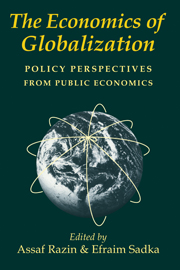Book contents
- Frontmatter
- Contents
- Preface
- List of Contributors
- Introduction
- I International Mobility of Technology
- II Capital Flows and Exchange-Rate Misalignment
- III Tax Incentives and Patterns of Capital Flows
- IV Limits to Income Redistribution in Federal Systems
- V Tax Harmonization, Tax Coordination, and the “Disappearing Taxpayer”
- 8 Is There a Need for a World Tax Organization?
- 9 Taxation, Financial Innovation, and Integrated Financial Markets: Some Implications for Tax Coordination in the European Union
- 10 Can International Commodity-Tax Harmonization Be Pareto-Improving When Governments Supply Public Goods?
- 11 Fiscal Separation with Economic Integration: Israel and the Palestinian Authority
- VI Political-Economy Aspects of International Tax Competition
- VII Migration of Skilled and Unskilled Labor
- VIII Fiscal Aspects of Monetary Unification
- Index
11 - Fiscal Separation with Economic Integration: Israel and the Palestinian Authority
Published online by Cambridge University Press: 28 January 2010
- Frontmatter
- Contents
- Preface
- List of Contributors
- Introduction
- I International Mobility of Technology
- II Capital Flows and Exchange-Rate Misalignment
- III Tax Incentives and Patterns of Capital Flows
- IV Limits to Income Redistribution in Federal Systems
- V Tax Harmonization, Tax Coordination, and the “Disappearing Taxpayer”
- 8 Is There a Need for a World Tax Organization?
- 9 Taxation, Financial Innovation, and Integrated Financial Markets: Some Implications for Tax Coordination in the European Union
- 10 Can International Commodity-Tax Harmonization Be Pareto-Improving When Governments Supply Public Goods?
- 11 Fiscal Separation with Economic Integration: Israel and the Palestinian Authority
- VI Political-Economy Aspects of International Tax Competition
- VII Migration of Skilled and Unskilled Labor
- VIII Fiscal Aspects of Monetary Unification
- Index
Summary
Introduction
The Israeli–Palestinian accord of 1994 led to the establishment of the Palestinian National Authority (PNA), with economic responsibilities and its own fiscal jurisdiction in the Gaza Strip and parts of the West Bank. Political separation, in that case, was to be accompanied by a common external tariff and by removal of some existing obstacles to fuller economic integration of the Palestinian and Israeli economies. But the establishment of a separate fiscal jurisdiction meant that the need to coordinate fiscal policies, inherent in a customs-union framework, would have to be accommodated and that mechanisms would have to be found for the apportioning of tax revenues. Those problems and the solutions offered to them are the subjects of this study.
After providing a brief historical perspective and surveying the evolution of the situation that existed when the new regime was being negotiated, the fiscal problems raised by a common customs envelope will be analyzed. The arrangements ultimately made to deal with those problems are then discussed, with special emphasis on the questions of decision- sharing and of the tax-clearance mechanism.
The few years that have passed since the establishment of the PNA have been too short a period to allow complete evaluation of the workings of the system as it has functioned in practice, the more so because political and security developments have overshadowed and disrupted the economic scene for most of the period.
- Type
- Chapter
- Information
- The Economics of GlobalizationPolicy Perspectives from Public Economics, pp. 246 - 264Publisher: Cambridge University PressPrint publication year: 1999
- 3
- Cited by



